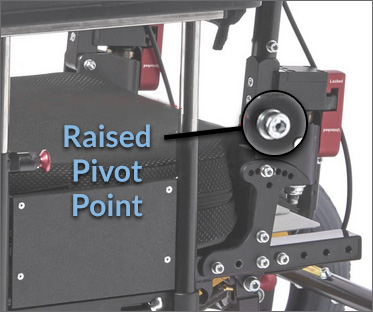3 Reasons to Provide Dynamic Posterior Movement of the Trunk and Pelvis
 Michelle L. Lange, OTR/L, ABDA, ATP/SMS
Michelle L. Lange, OTR/L, ABDA, ATP/SMS
Updated 9/21/2022
Our last blog discussed providing dynamic movement at the pelvis, more specifically at the hip joint. If the pelvis moves posteriorly, the trunk will move posteriorly as well. So if posterior movement of the trunk is desired, dynamic seating components which allow posterior movement of the pelvis are provided, namely a dynamic back, which opens the seat to back angle in response to client movement and force. This movement may be utilized to protect back canes, back mounting hardware, absorb extensor forces, and simply to provide active movement. If the client experiences a loss of trunk position upon return to upright, it is important to ensure that adequate lateral and anterior trunk support is used.
It is possible to provide movement at the junction between the trunk and the pelvis. This was accomplished in the past by a Dynamic Back from Miller's Adaptive Technologies designed for use with a biangular back. The pelvis was held in position by the lower portion of the back. The upper portion of the back moved posteriorly in response to client forces. This strategy maintained pelvic position while absorbing client force. This product is no longer available.
Shear Forces and a Dynamic Back
Opening the seat to back angle can lead to shear forces between the client’s trunk and the back of the seating system. One result of this shear is that the client may move in relationship to the back of the seating system, affecting the relative position of supports attached to the back, such as lateral trunk supports. Typically the amount of movement is not significant and so the client is not significantly out of alignment with these supports, but if the movement is greater, the lateral supports could end up in the client’s armpits during extension. Seating Dynamics Dynamic Rocker Back interface moves 10-15 degrees, providing movement without loss of position and reducing shear forces.
It is important to consider the pivot point of the dynamic back. Just as the optimal pivot point facilitates the pelvis returning to neutral after extending, the optimal pivot point also reduces shear in the back. This is discussed further in our previous blog.

I also like at times to be able to keep the thigh – pelvic angle in a predetermined configuration( based upon clinical assessment findings of client tolerances at hip joint) and then consider lumbar- thoracic dynamic movement which in essence facilitates thoracic extension and all the related benefits while maintaining hip joint and pelvic stability. We dont often think about this as a dynamic joint in the body but in the seated position can make a big difference – some food for thought:)
Excellent comment Sharon! This is exactly why I prefer a higher pivot point on a dynamic back. This helps to maintain the pelvis in position and allow extension at that lumbar area. Movement is great, but the angle of that movement can help prevent loss of position.